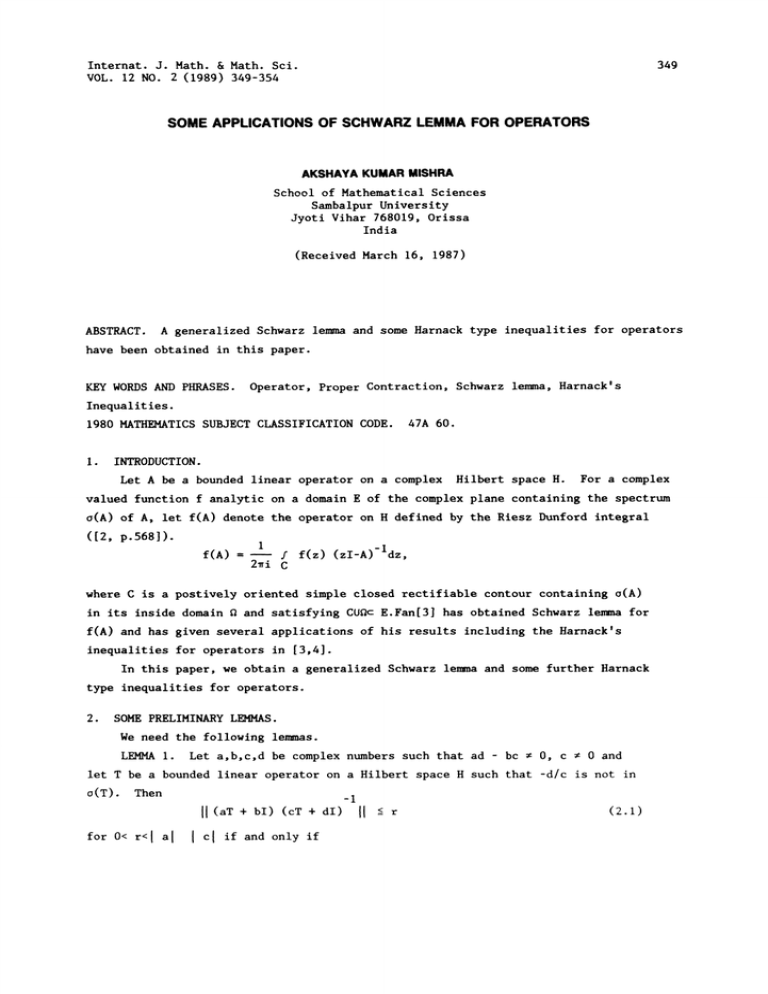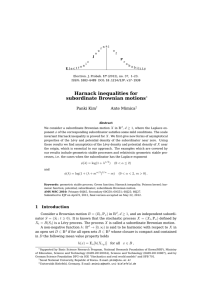APPLICATIONS LEMMA OPERATORS FOR
advertisement

Internat. J. Math. & Math. Sci.
VOL. 12 NO. 2 (1989) 349-354
349
SOME APPLICATIONS OF SCHWARZ LEMMA FOR OPERATORS
AKSHAYA KUMAR MISHRA
School of Mathematical Sciences
Sambalpur University
Jyoti Vihar 768019, Orissa
India
(Received March 16, 1987)
ABSTRACT.
A generalized Schwarz lemma and some Harnack type inequalities for operators
have been obtained in this paper.
KEY WORDS AND PHRASES.
Operator, Proper Contraction, Schwarz lemma, Harnack’
Inequalities.
1980 MATHEMATICS SUBJECT CLASSIFICATION CODE.
1.
47A 60.
INTRODUCTION.
Let A be a bounded linear operator on a complex Hilbert space H. For a complex
valued function f analytic on a domain E of the complex plane containing the spectrum
o(A) of A, let f(A) denote the operator on H defined by the Riesz Dunford integral
([2, p.568]).
1
f(A)--- / f(z) (zl-A)
dz,
2i C
where C is a postively oriented simple closed rectifiable contour containing o(A)
in its inside domain R and satisfying CURe E.Fan[3] has obtained Schwarz 1emma for
f(A) and has given several applications of his results including the Harnack’s
inequalities for operators in [3,4].
In this paper, we obtain a generalized Schwarz lemma and some further Harnack
type inequalities for operators.
2.
SOME PRELIMINARY LEMMAS.
We need the following lemmas.
bc
0, c # 0 and
LEMMA i. Let a,b,c,d be complex numbers such that ad
let T be a bounded linear operator on a Hilbert space H such that -d/c is not in
o(T). Then
-i
(2.1)
r
ll(aT + bl) (cT + dl)
II
for 0< r<
a
c
if and only if
350
A.K. MISHRA
=b
T
r
2
r{ad
d
+
[a[
2
r
2
Ic[
bc[
(2.2)
_<-
I
2
[al
-r2
2
I=12
Equality holds in (2.1) and (2.2) simultaneously.
The inequality (2.1) is true if and only if
PROOF.
(aT + bl) (cT + dl) -I >. 0
(T* +I) -I (T* + I)
r2I
or
[r2(T* + I)
(cT* +dl)
(cT + dl)
(aT* bl)(aT + bl)] (cT+dl)
The operator inside the square brackets can be written as
r
2
lal
ad-bel
2
ab
I
r21cl
r
2
cd
2
r2e
ab
T* +
{T’T+
la12 r21cl
r2d12
(lal 2 r21cl 2
Ib
T+
2
lal
2
r21cl
2
I}
)2
or
r
2
lad
bc
2
r21=l
lal
I -[T*+
2
a
lal
r
2
2
c
r21=l
b
I
r
2
2
I
lal
2
r21=l
This last expression is a positive operator if and only if
completes the proof.
LEMMA 2. Let a,b,c,d and T be as in Lemma I.
ll(aT + bl)(cT+
bd
1)
dI--
Idl
=
fo= 0
|T
<
Idl /I=I
Ed
T+
r
2
2
r21cl
(2.2) holds.
This
Then,
ac
2
2
III .<
rlad be
Idl 2 -=1=12 2
(2.3)
Equality holds in (2.3) if and only if
if and only if llT#<-r.
r.
PROOF.
ll{(aT+bl)(
The inequality (2.3) is equivalent to
Idl 2
r21cl 2
(b
r
2
aE) (cT + dl)} (cT +
dl)-lll
rlad-
.<
bc
After simplication the above can be written as
(dT + r 2 El) (cT +
dl)-lll
_<- r
Now an application of Lemma 1 shows that (2.4) is equivalent to
3.
A GENERALIZED SCHWARZ LEMMA.
Let D denote the open unit disc {z:
z
I<i} n
{f
H(D):
If(z)l
<i
z
D} and let B O (D)
l{r
the complex plane and let H(D)
be the class of complex valued functions analytic in D.
B(D)
T
{f
Further, let
B (D): f(0)
0}
SOME APPLICATIONS OF SCHWARZ LEMMA FOR OPERATORS
Let f be in B(O) and let A be a proper contraction on a Hilbert
THEOREM I.
space H.
351
Then,
+
A,
__< f<A) II__<
l-If(O)
3.1
All
If(O)
l+
tIAll
B(D) and A is a proper contraction, by a result of F and
f(A) is also a proper contraction. Now, if we define
the complex valued function g by g(z)
(f(z)- f(0)) (l-f(0) f(z))-ithen g is in
-1
(T-f(0)I) (l-f(0) T)
B (D) and g(A)
is also a proper contraction. Further by
o
the operator version of Schwarz lenna ([3, Corollary 2, p.280]),
PROOF.
Since f is in
([3, Theorem i, p.276]), T
g(A)ll _<If we take a
d
I, b
(3.2)
A II.
f(0),
f(0)
c
and r
IIAII
then (3.2) is
in Lemma
equivalent to
I- }{A{{ 2 f(0)
l-{f(O)12{lA{{
(l-[f(O){2)ll-- All
2
1- {f<0)12llAl{
2
Using triangle inequality we get both the inequalities in (3.1).
CORALLARY I.
An
PROOF.
bzn+
Let f in B (D) be given by the series f(z)
o
b 0, and let A be a proper contraction on a Hilbert space H.
-[b[
)
f(A)
{{l{An{{
(3.3)
1+{b BA
AI{
The function g, defined by g(z)
Then
(f(z)/zn),
z
0 and
g(0)=b,
B(D) and f(A)
Ang(A). Hence the result follows from Theorem I.
REMARK. The author learned from Professor R. Finn that Theorem
is in
follows
independently from some results of K. Fan that are now in press.
4.
SOME HARNACK TYPE INEQUALITIES.
Let P(a, 8), 0 _-< a<l, 0< 8 <_- i, denote the subclass of functions p in H(D)
satisfying p(0)
and
p(z)- 1{
< i, z inD.
[(2B-l)p(z) + (i- 2aB)
This class of functions have been introduced and studied by Juneja and Mogra [5].
It has been shown in [5] that the n th Taylor coefficient a of a function p
n
satisfies the sharp inequality
(l-a).
Observe that
[
28
n
la
P(0,1) ={p
P(a,l) ={p
P(O,8) ={p
e
e
e
H(D): p(0) =i, Re p(z)
H(D): p(0) =i, Re p(z)
H(D): p(O) =i, [p(z)-
0, z in D },
z in D },
,
2(i-)
2(i-8)
}’
A.K. MISHRA
352
and
P(a,6)cP(0,1), for all
We prove the following
admissible choices of a and [3
theorem which extends a distortion theorem by Kapoor and the author ([6, Theorem !,
p.86]).
Let p in P(a,6) be given by the series p(z)
1+2b(1-a) [3za+
_<- 1, z in D and let A be a proper contraction on a Hilbert space H. Then,
THEOREM 2.
0 <
[b[
+ IIAII [b[ + (1-2a[3
<_-
p(A)
II[b[ + (1-213)(
+11 A
>=
P(A)
l+II A
1+][
i+[[
+Ira p(A)
,Ib -(1-213 )(II A ,+lb
AI][b[ + (I-2aB)(II
1+[[
A[l[b[+ (1-26)([[
_<_
213(i-a)([[
A[[
+[b[ )(
An
+
[b[)ll
+[b[)ll An
(4 1)
)[[ An
+[b[
)(H A
I+H
(i+II
PROOF.
(I-2a[3
A
A[[[b[- (1-2a[3)(11 AH +[b[ )11 An[[
AH[b[-(I-26 )([I A [[+[b[ [IAnH
Re p(A)
w in B
[[[b[-
A
I+
)(IIA
(4.2)
[)llAnll
(4.3)
I <_- Re p(A),
+[b[ )II An
+[b[ [IAn[[
All
All
(4.4)
I
A[[[b[)[[
i+[[
A[I[b[ )2 (I-26)2([[A[[ +[b[
)[[ Anl[ 2
I
From the definition of P(,[3), it follows that there exists a function
(D) such that
O
p(z)
{i+
p(A)
{i+
(I-26) w(z)} {I+ (1-28) w(z)
}-I,
z in D
and
(I-26) T} {i+ (1-26) T} -I
Further, it is observed that w(z)=
i., we can say
T
bzn+
An
<-
w(A)
where T= w(A)
where z in D.
All
+]
Hence by Corollary
b
r
1+[{ A{{
Now, choosing
a
I-2c6, c= 1-213, b= dl in Lemma 2, (4.6) is equivalent, to
l-r
lip(A)
2
(i-2e6) (1-213)
I_r2(I_2
[B) 2
2r
i_r2(]_2 [3)2
Hence
1-(1-26)
r
{{
p(A)
(I-e)[3
_<-
+
(4.6)
SOME APPLICATIONS OF SCHWARZ LEMMA FOR OPERATORS
353
Substituting the value of r in the above inequality, we get (4.1) and 4.2).
Also,
1-r2(1-28)
(1-2 )2
[p(A)
+/-Re
1-r2(1-2 e)(1-28)
I-r2(i-2 8 )2
(1-25)
r
.I] <I p(A)
2
2r( 1_<-
l-r
This gives
(4.3) and (4.4).
Im p(A)=
+/-
Im [p(A)
From this (4.5) follows.
REMARK.
)l
I
1-213 )2
2
(1-2c)
1-23
I
1-r< -2 6>
1-r2(1-2
p(A)
I
Similarly,
1-r
+/-
2
I
_r
2
3)(1-2
(1-23
)2
23 (l-a)
I
I
_-<
-r
Z
r
(1-2f )Z
I
This completes the proof.
The right hand side of
(4.1) and (4.2) are increasing and decreasing
I,
function of
b
respectively. For the case
b[ =i, a=O and =i, our Theorem
2 includes some results of Fan ([3, Corollary 3,P281], [4, Proposition 2,P.335]).
ACKNOWLEDGEMENT.
The author wishes to thank Professor R. Finn for his
useful suggestions.
REFERENCES
I.
2.
CARATHEODORY, C. Theory of functions of a complex variable, Vol.ll, Chelsea
Publishing Company, New York, 1954.
DUNFORD, N. and SCHWARTZ, J.T. Linear Operators, Part I, General Theory,
New York, Interscience, 1958.
Analytic functions of a proper contraction, Math. Z. 160 (1978),
275-290.
3.
FAN, KY.
4.
FAN, KY. Harnack’s inequalities for operators, General Inequalities 2, Edited
by E.F. Beckenbach, Birkhauser Verlarg, Basel, 1980.
JUNEJA, O.P. and MOGRA, M.L. Radius of convexity for certain classes of
5.
analytic functions, Pacific J. Math. 78 (1978), 359-368.
6.
KAPOOR, G.P. and MISHRA, A.K. Distortion theorems for some elassc.
analytic functions, Houston J. Math. 8 (1982), 85-92.






